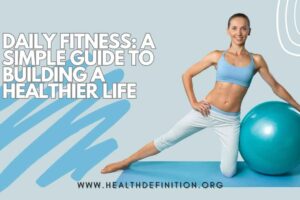
Health-related fitness is essential for maintaining overall well-being and preventing chronic diseases. Unlike skill-related fitness, which focuses on athletic abilities, health-related fitness comprises components that contribute to the efficient functioning of the body and enhance quality of life. These components include cardiovascular endurance, muscular strength, muscular endurance, flexibility, and body composition. Understanding and improving these elements can lead to a healthier and more active lifestyle.
This article provides an in-depth exploration of these fitness components, their significance, and ways to improve them. Additionally, it discusses the role of proper nutrition, mental health, and lifestyle habits in maintaining optimal health-related fitness.
1. Cardiovascular Endurance
Definition: Cardiovascular endurance refers to the ability of the heart, lungs, and blood vessels to deliver oxygen to working muscles efficiently during sustained physical activity.
Importance:
- Enhances heart and lung efficiency
- Reduces the risk of cardiovascular diseases such as hypertension, heart attacks, and stroke
- Improves stamina, energy levels, and overall quality of life
- Supports weight management by improving calorie-burning efficiency
- Helps control blood sugar and cholesterol levels
Ways to Improve:
- Engage in aerobic exercises like running, swimming, cycling, and brisk walking
- Practice high-intensity interval training (HIIT) for increased cardiovascular efficiency
- Participate in sports such as basketball, soccer, or tennis to boost endurance
- Maintain consistency with at least 150 minutes of moderate-intensity or 75 minutes of vigorous-intensity aerobic activity per week
- Monitor heart rate during exercise to ensure maximum efficiency
2. Muscular Strength
Definition: Muscular strength is the maximum amount of force a muscle or muscle group can exert against resistance in a single effort.
Importance:
- Helps in performing daily tasks efficiently, such as lifting, pushing, or carrying objects
- Supports joint health and reduces the risk of injury
- Enhances metabolic rate, aiding in weight management and fat loss
- Improves bone density and reduces the risk of osteoporosis
- Increases overall power and athletic performance
Ways to Improve:
- Perform resistance training exercises such as weightlifting, push-ups, deadlifts, and squats
- Increase intensity progressively by adding more weight or resistance
- Focus on compound movements like bench press, deadlifts, and lunges that target multiple muscle groups
- Ensure proper nutrition with adequate protein intake to support muscle growth
- Allow sufficient rest and recovery between strength training sessions

3. Muscular Endurance
Definition: Muscular endurance is the ability of a muscle or muscle group to sustain repeated contractions over time without fatigue.
Importance:
- Supports posture and reduces the risk of musculoskeletal disorders
- Enhances athletic performance and endurance sports capability
- Facilitates daily activities that require repetitive motion, such as carrying groceries or climbing stairs
- Prevents early onset of fatigue during physical exertion
- Improves overall muscular efficiency and stamina
Ways to Improve:
- Engage in bodyweight exercises like planks, sit-ups, and lunges
- Perform circuit training with moderate resistance and high repetitions
- Include endurance-based activities like rowing, cycling, and swimming
- Increase training volume gradually to build muscular resilience
- Combine resistance and cardio workouts for optimal endurance development
4. Flexibility
Definition: Flexibility refers to the range of motion available at a joint or group of joints.
Importance:
- Prevents injuries and muscle imbalances
- Reduces muscle stiffness and improves posture
- Enhances overall movement efficiency and relaxation
- Helps in stress reduction and muscle recovery
- Supports better athletic performance and functional mobility
Ways to Improve:
- Incorporate static stretching exercises such as hamstring and quadriceps stretches
- Practice dynamic stretching before workouts to prepare muscles for activity
- Engage in activities like yoga and Pilates to enhance overall flexibility
- Perform foam rolling and self-myofascial release techniques to reduce muscle tension
- Stretch after workouts to improve recovery and prevent stiffness
5. Body Composition
Definition: Body composition refers to the proportion of fat and non-fat mass (muscles, bones, water, and organs) in the body.
Importance:
- Helps in maintaining a healthy weight and reducing obesity-related diseases
- Improves physical appearance and self-confidence
- Enhances physical performance by reducing excess fat and increasing lean muscle mass
- Supports heart health by preventing high cholesterol and hypertension
- Boosts metabolic efficiency and overall well-being
Ways to Improve:
- Follow a balanced diet with controlled calorie intake
- Engage in regular physical activity, combining both cardiovascular and strength training
- Monitor body fat percentage through methods like BMI calculation, skinfold measurements, or bioelectrical impedance analysis
- Stay hydrated and avoid processed foods that contribute to unhealthy fat accumulation
- Aim for a healthy balance between muscle mass and body fat for optimal health
The Role of Nutrition in Health-Related Fitness
Proper nutrition plays a critical role in maintaining all five components of health-related fitness. A balanced diet rich in lean proteins, healthy fats, complex carbohydrates, vitamins, and minerals supports overall physical Health-related fitness. Hydration is also essential for optimal performance and recovery.
Key Nutritional Tips:
- Consume lean proteins (chicken, fish, tofu, beans) to build and repair muscles
- Incorporate healthy fats (avocados, nuts, olive oil) for sustained energy
- Prioritize complex carbohydrates (whole grains, vegetables, fruits) for sustained endurance
- Stay hydrated by drinking at least 2-3 liters of water daily
- Avoid excessive sugar, processed foods, and unhealthy fats to maintain optimal body composition

The Connection Between Mental Health and Physical Fitness
Physical Health-related fitness is not just about the body; it also impacts mental health. Regular exercise reduces stress, anxiety, and depression while promoting better sleep and overall mood.
Mental Health Benefits of Fitness:
- Releases endorphins that promote happiness and reduce stress
- Improves cognitive function and concentration
- Enhances self-esteem and body image
- Reduces symptoms of anxiety and depression
- Encourages social interaction and teamwork through group activities
Lifestyle Habits for Long-Term Fitness Maintenance
Maintaining health-related fitness requires consistent effort and healthy lifestyle choices. Here are some habits that support long-term well-being:
- Get enough sleep: Aim for 7-9 hours per night to support muscle recovery and mental clarity.
- Manage stress: Practice mindfulness, meditation, or hobbies that help reduce stress.
- Stay active daily: Incorporate movement throughout the day by walking, stretching, or engaging in recreational activities.
- Avoid smoking and excessive alcohol consumption: These habits negatively impact cardiovascular health and overall fitness.
- Set realistic fitness goals: Having a clear plan and tracking progress keeps motivation high.
What are the 10 fitness components?
Improving health-related fitness components enhances overall well-being and longevity. By incorporating a combination of cardiovascular endurance, muscular strength, muscular endurance, flexibility, and body composition into daily routines, individuals can lead healthier lives. Regular exercise, proper nutrition, mental well-being, and lifestyle modifications contribute significantly to achieving and maintaining optimal health. Investing in health-related fitness today ensures a better quality of life for years to come.
health-related fitness components:
- Cardiovascular Endurance – The ability of the heart, lungs, and blood vessels to deliver oxygen efficiently during prolonged physical activity.
- Muscular Strength – The maximum amount of force a muscle or muscle group can exert in a single effort.
- Muscular Endurance – The ability of a muscle or muscle group to perform repeated contractions over time without fatigue.
- Flexibility – The range of motion available at a joint or group of joints.
- Body Composition – The proportion of fat, muscle, bone, and other tissues that make up the body.

Frequently Asked Questions (FAQs)
How often should I exercise to improve health-related fitness?
It is recommended to engage in at least 150 minutes of moderate-intensity exercise or 75 minutes of vigorous-intensity exercise per week, along with two or more strength-training sessions.
Can I improve flexibility at any age?
Yes, flexibility can be improved at any age through consistent stretching exercises, yoga, and mobility training.
What is the best diet for maintaining good body composition?
A balanced diet rich in lean proteins, healthy fats, whole grains, and plenty of fruits and vegetables, along with proper hydration, is ideal for maintaining good body composition.
Does mental health affect physical Health-related fitness?
Yes, poor mental health can lead to reduced motivation, increased stress, and unhealthy lifestyle choices, all of which negatively impact physical Health-related fitness.
How can I track my Health-related fitness progress?
Tracking progress can be done through Health-related fitness apps, wearable devices, regular body measurements, and performance improvements in exercises.






